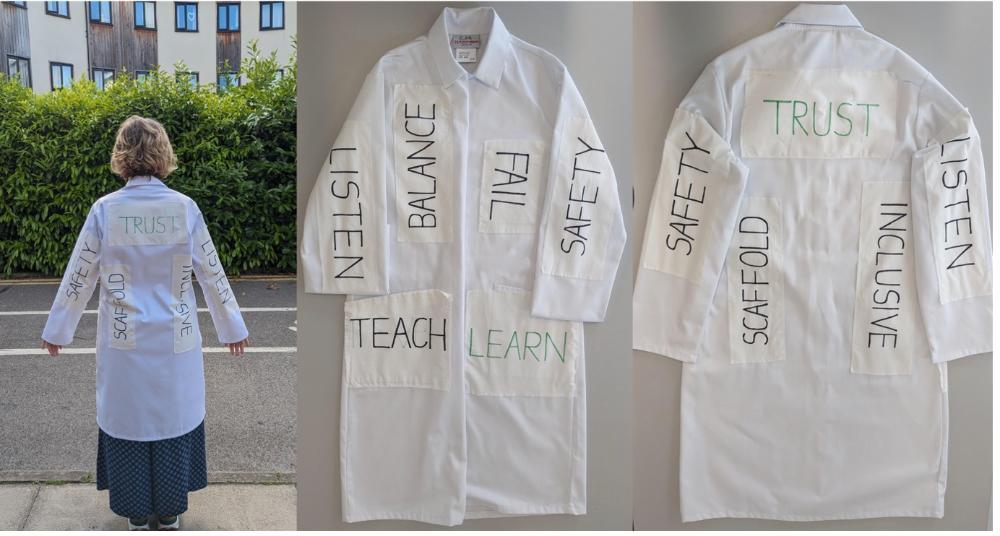23 Sep 2024
This blog was written by Kathryn Coventry, a Lecturer in Fashion Atelier, and a PgCert student from the 2023/2024 cohort, as part of the Higher Education in Practice: Personal reflections on your discipline and the wider context of higher education submission.
/prod01/channel_13/uca-creative-education/media/research-and-enterprise/nikolai/Kathryn-1-604X392.jpg)
This image is of current final year students having just received their Atelier white coats in a presentation at the start of their final year. This was the first level 4 cohort I taught where I had a year lead role. The photograph was taken outside the student accommodation at UCA Epsom.
When I consider the biggest barrier to my students learning at university, mental health is the most common cause. NICE (2020) documents that students are ‘at increased risk of mental health issues due to multiple factors’, some pre-existing their university experience, and some directly caused by it. “Transition into and through HE is often perceived as a fraught process for many students, but particularly for those from diverse backgrounds.” (O’Shea, 2020 cited in Comunian et al, 2023). I have decided to focus on students mental health as the it’s the prevalent outcome, regardless of cause. “Anxiety is a fear response to a perceived threat. Students become anxious about education when they view it or the environment as a threat to them.” (Advance HE, 2022). So how do I try to reduce that threat to their learning experience at university?
The Education for mental health toolkit (Advance HE, 2022) states that “Curriculum that is well designed, taught and assessed can support a positive spiral of good wellbeing and good learning”. Achieving the right balance between stretch, boredom and anxiety can be a challenge across students with varying abilities, previous experiences and confidence, not to mention any pre-existing conditions that may impact on their learning.
“The key to understanding the relationship between boredom, anxiety, stretch and learning is finding productive balance. Vygotsky’s concept of scaffolded learning provides a pedagogic framework in which the aim of the curriculum should be to stretch students to their zone of proximal development – just outside their current comfort zone. This is likely to engage students in stretch, avoiding both boredom and anxiety.” (Advance HE, 2022)
There is also the conflict of care as their pastoral tutor and the academic who will ultimately being delivering and assessing their work. “A ‘caring relation’ is simply a starting point and an invitation for tutors to gain greater competence, helping students discover what they need rather than what we want to give” (Davenport, 2022).
Finding how best to navigate my way through this caring role has been my biggest challenge in the three years I have held my current position. Initially there was a tendency to think a friendly ear, some kind words and an almost maternal role was what was required. How wrong I was!
“As we engage our students in dialogue, we learn about their needs, working habits, interests, and talents. We gain important ideas from them about how to build our lessons and plan for their individual progress”. I have learnt from them that listening without judgement or preconceived ideas is the most important aspect of our relationship. “As we listen to our students, we gain their trust and, in an on-going relation of care and trust, it is more likely that students will accept what we try to teach. They will not see our efforts as ‘interference’ but, rather, as cooperative work proceeding from the integrity of the relation”. (Noddings, 1999 cited in Noddings, 2005). Working with them to implement the best and most appropriate support from specialists either within or outside the university is key.
This brings it back to my responsibility to structure the curriculum to best support the students. Previously, I had tended to focus too much on horizontal alignment but we are now implementing more vertical alignment into our course planning. “Curriculum alignment can be vertical when teachers of various grades team up along a single subject, or horizontal when those in the same grade level teach different subjects”. (Gray, 2021)
I have also become aware of building psychological safety into their classroom experience which can again start with the curriculum. Ensuring resources and content are well directed, diverse, inclusive and stage appropriate, escalating the content as they progress through their first year is imperative. “the social learning environment is a safe place in which to experiment, make mistakes and correct misconceptions. This has implications for inclusion, as students who are marginalised by in lesson experiences or by curriculum content, are likely to feel a reduced sense of belonging and lower levels of psychological safety.” (Advance HE, 2022).
I decided to take inspiration for my visual response to this issue from the photo of the final year students in their Atelier coats. I took my own coat and basted on large labels which highlight the role I play in their education. The first image is of me wearing my coat, taken in the same location, outside the student accommodation on the campus at UCA Epsom.

References
- Advance HE.ac.uk (2022) Education for Mental Health Toolkit At: https://www.advance-he.ac.uk/teaching-and-learning/curricula-development/education-mental-health-toolkit (accessed 19/05/2024)
- Comunian, R., Dent, T., O’Brien, D., Read, T. and Wreyford, N. (2023) Making the Creative Majority: A report for the All-Party Parliamentary Group for Creative Diversity on ‘What Works’ to support diversity and inclusion in creative education and the talent pipeline, with a focus on the 16+ age category. APPG. At: https://www.kcl.ac.uk/cultural/projects/creative-majority-education (accessed 19/05/2024)
- Davenport. A (2022) Care as choreographed: what is the role of care in higher education teaching? At: https://juice-journal.com/2022/12/07/care-as-choreographed-what-is-the-role-of-care-in-higher-education-teaching/ (accessed 19/05/2024)
- Gray, K. (2021) Horizontally and Vertically Aligning Curriculum. Study.com. At: https://study.com/academy/lesson/horizontally-and-vertically-aligning-curriculum.html (accessed 20/05/2024)
- NICE.org, (2020) Mental Health in students: What are the risk factors? At: https://cks.nice.org.uk/topics/mental-health-in-students/background-information/risk-factors/ (accessed 19/05/2024)
- Noddings, N. (2005). ‘Caring in education’, The encyclopaedia of pedagogy and informal education. At: https://infed.org/mobi/caring-in-education/ (accessed 20/05/2024)